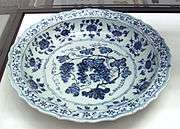Overglaze decoration
Overglaze decoration, overglaze enamelling or on-glaze decoration is a method of decorating pottery, most often porcelain, where the coloured decoration is applied on top of the already fired and glazed surface, and then fixed in a second firing at a relatively low temperature. It is often described as producing "enamelled" decoration. The colours fuse on to the glaze, so the decoration becomes durable. This decorative firing is usually done at a lower temperature which allows for a more varied and vidid palette of colours, using pigments which will not colour correctly at the high temperature necessary to fire the porcelain body. Historically, a relatively narrow range of colours could be achieved with underglaze decoration, where the coloured pattern is applied before glazing, notably the cobalt blue of blue and white porcelain.
Many historical styles, for example Imari ware, Chinese doucai and wucai, combine the two types of decoration. In such cases the first firing for the body, underglaze decoration and glaze is followed by the second firing after the overglaze enamels have been applied.
The technique was first seen in Chinese ceramics in Cizhou stoneware from as early as the 12th century, with use on porcelain following within a century, though it did not become predominant until later, and the full possibilities were not realized until the 17th century.[1] Some techniques use thin metal leaf as well as the more usual pigments, which are typically applied in a liquid or paste form, painted by brush, or using stencils or transfer printing. Today overglaze decoration is much less commonly used, other than in traditionalist wares, as the range of colours available in underglaze has greatly expanded.
Notes
- ↑ Vainker, 117, 180–182
References
- Vainker, S.J., Chinese Pottery and Porcelain, 1991, British Museum Press, 9780714114705

.jpg)